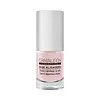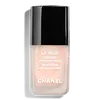What's inside
What's inside
 Key Ingredients
Key Ingredients

 Benefits
Benefits

 Concerns
Concerns

 Ingredients Side-by-side
Ingredients Side-by-side

Butyl Acetate
MaskingEthyl Acetate
PerfumingNitrocellulose
Adipic Acid/Neopentyl Glycol/Trimellitic Anhydride Copolymer
Acetyl Tributyl Citrate
MaskingIsopropyl Alcohol
SolventAcrylates Copolymer
Silica
AbrasiveStearalkonium Bentonite
Gel FormingStyrene/Acrylates Copolymer
N-Butyl Alcohol
PerfumingBenzophenone-1
UV AbsorberCocos Nucifera Oil
MaskingTocopheryl Acetate
AntioxidantTrimethylpentanediyl Dibenzoate
Polyvinyl Butyral
Benzophenone-3
UV AbsorberStearalkonium Hectorite
Gel FormingCI 77491
Cosmetic ColorantCI 77891
Cosmetic ColorantButyl Acetate, Ethyl Acetate, Nitrocellulose, Adipic Acid/Neopentyl Glycol/Trimellitic Anhydride Copolymer, Acetyl Tributyl Citrate, Isopropyl Alcohol, Acrylates Copolymer, Silica, Stearalkonium Bentonite, Styrene/Acrylates Copolymer, N-Butyl Alcohol, Benzophenone-1, Cocos Nucifera Oil, Tocopheryl Acetate, Trimethylpentanediyl Dibenzoate, Polyvinyl Butyral, Benzophenone-3, Stearalkonium Hectorite, CI 77491, CI 77891
Butyl Acetate
MaskingEthyl Acetate
PerfumingNitrocellulose
Adipic Acid/Neopentyl Glycol/Trimellitic Anhydride Copolymer
Acetyl Tributyl Citrate
MaskingIsopropyl Alcohol
SolventStearalkonium Bentonite
Gel FormingArgania Spinosa Kernel Oil
EmollientAcrylates Copolymer
Silica
AbrasiveN-Butyl Alcohol
PerfumingBenzophenone-1
UV AbsorberDiacetone Alcohol
MaskingHexanal
MaskingTocopheryl Acetate
AntioxidantTrimethylpentanediyl Dibenzoate
Algae Extract
EmollientMannitol
HumectantPhosphoric Acid
BufferingSolum Diatomeae
AbrasiveZinc Sulfate
AntimicrobialCI 19140
Cosmetic ColorantCI 77491
Cosmetic ColorantCI 77891
Cosmetic ColorantButyl Acetate, Ethyl Acetate, Nitrocellulose, Adipic Acid/Neopentyl Glycol/Trimellitic Anhydride Copolymer, Acetyl Tributyl Citrate, Isopropyl Alcohol, Stearalkonium Bentonite, Argania Spinosa Kernel Oil, Acrylates Copolymer, Silica, N-Butyl Alcohol, Benzophenone-1, Diacetone Alcohol, Hexanal, Tocopheryl Acetate, Trimethylpentanediyl Dibenzoate, Algae Extract, Mannitol, Phosphoric Acid, Solum Diatomeae, Zinc Sulfate, CI 19140, CI 77491, CI 77891
Ingredients Explained
These ingredients are found in both products.
Ingredients higher up in an ingredient list are typically present in a larger amount.
Acetyl Tributyl Citrate is a fragrance.
Acrylates Copolymer is used as a film-forming agent and texture enhancer.
After applied, Acrylates Copolymer forms a thin film cover that helps skin feel more soft. It can help sunscreens become more water-resistant.
It is also used to make a product more thick.
Learn more about Acrylates CopolymerWe don't have a description for Adipic Acid/Neopentyl Glycol/Trimellitic Anhydride Copolymer yet.
Benzophenone-1 absorbs UV.
We don't have a description for Butyl Acetate yet.
Ci 77491 is also hydrated iron III oxide. It's sole purpose is to give a red/pink hue to products.
Iron III oxides are classified as inorganic chemicals for coloring.
Synthetically created Ci 77491 is considered safer than those naturally found. This is because the synthetically created version may contain less impurities. Iron oxides are generally non-toxic and non-allergenic.
Learn more about CI 77491Ci 77891 is a white pigment from Titanium dioxide. It is naturally found in minerals such as rutile and ilmenite.
It's main function is to add a white color to cosmetics. It can also be mixed with other colors to create different shades.
Ci 77891 is commonly found in sunscreens due to its ability to block UV rays.
Learn more about CI 77891Ethyl Acetate is a fragrance.
Isopropyl Alcohol is more commonly known as rubbing alcohol. It is most commonly used as a solvent, meaning it helps other ingredients dissolve.
This ingredient is an astringent alcohol. Astringent alcohols may also irritate skin as they high amounts may strip away your skin's natural oils.
Other types of astringent alcohols include:
According to the National Rosacea Society based in the US, you should be mindful of products with these alcohols in the top half of ingredients.
Any type of sanitizing product will have high amounts of alcohol to help kill bacteria and viruses.
Learn more about Isopropyl AlcoholN-Butyl Alcohol is a fragrance.
We don't have a description for Nitrocellulose yet.
Silica, also known as silicon dioxide, is a naturally occurring mineral. It is used as a fine, spherical, and porous powder in cosmetics.
Though it has exfoliant properties, the function of silica varies depending on the product.
The unique structure of silica enhances the spreadability and adds smoothness, making it a great texture enhancer.
It is also used as an active carrier, emulsifier, and mattifier due to its ability to absorb excess oil.
In some products, tiny microneedles called spicules are made from silica or hydrolyzed sponge. When you rub them in, they lightly polish away dead skin layers and enhance the penetration of active ingredients.
Learn more about SilicaWe don't have a description for Stearalkonium Bentonite yet.
Tocopheryl Acetate is AKA Vitamin E. It is an antioxidant and protects your skin from free radicals. Free radicals damage the skin by breaking down collagen.
One study found using Tocopheryl Acetate with Vitamin C decreased the number of sunburned cells.
Tocopheryl Acetate is commonly found in both skincare and dietary supplements.
Learn more about Tocopheryl AcetateWe don't have a description for Trimethylpentanediyl Dibenzoate yet.